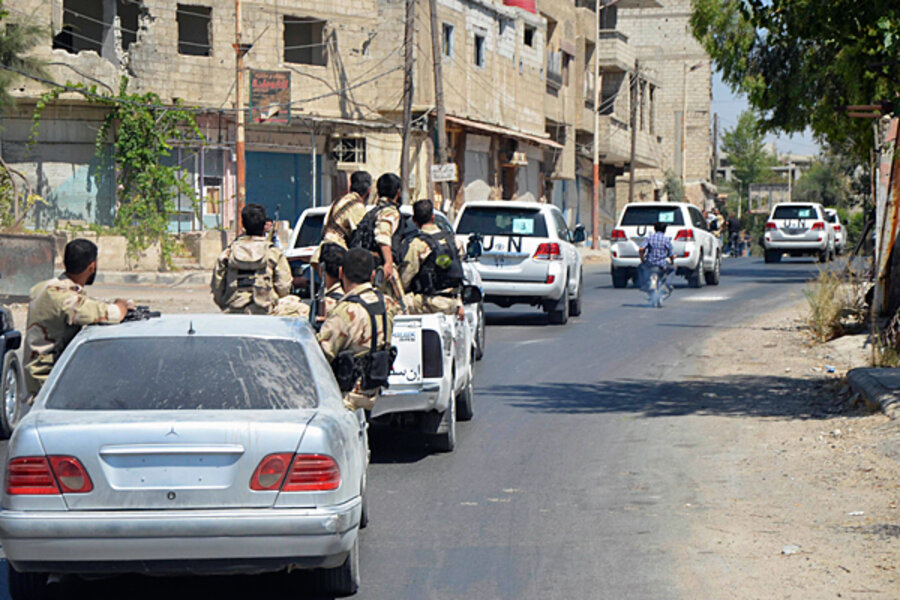Why Syria's chemical weapons would be difficult target for US strike
| Washington
It looks as if the US is about to attack Syria because the Syrian government used chemical weapons on its own people. US officials have made it clear that a main goal of such a strike would be to deter future use of this particular weapon of mass destruction, by Syria or anyone else.
White House spokesman Jay Carney on Tuesday said that since the end of World War I the Chemical Weapons Convention and other multilateral efforts have established an international norm against use of poison gas.
“The use of chemical weapons on the scale that we saw on Aug. 21 cannot be ignored. It must be responded to, because to allow it to happen without a response would be to invite further use of chemical weapons and to have that international standard dissolved,” said Mr. Carney.
But here is one complication: From a military standpoint, chemical weapons themselves are a difficult target. Deterrence in this case might involve US strikes against the infrastructure that supports their use, including missiles and other delivery systems, and command-and-control sites, as opposed to chemical stocks.
For one thing, chemical weapons would not just harmlessly vaporize in an attack. If hit by US munitions, chemical dumps could release some poisons into the air or in liquid form on the ground. Predicting the environmental effect in the surrounding area would be extremely difficult.
US cruise missiles in particular would not be able to destroy chemical stocks. Their warheads are not big enough to incinerate chemical weapons.
“Air operations alone will likely be able to degrade Syria’s chemical weapons stockpile only to a certain extent, but not completely,” writes naval analyst Christopher Harmer of the Institute for the Study of War in a study of possible US actions in Syria.
Second, air strikes against chemical depots could allow extremist rebel factions access to any remaining stocks. With gates blown open and guards scattered or killed, Islamist groups might seize chemical weapons – a nightmare proliferation scenario.
Third, Syria’s chemical weapons stockpile is probably too big for the US to destroy without the kind of large scale, boots-on-the ground military operation that the Obama administration has already ruled out.
Syria has been acquiring and producing nerve gas and blistering agents for decades. At this point, it has tons of chemical weapons, according to an Arms Control Association assessment, deliverable by bombs, missiles, and artillery.
By now, this stockpile has probably been dispersed to many sites, away from Syria’s five known chemical weapons installations.
Fully controlling Syria’s chemical weapons – by destroying large portions of its accumulated stocks, interdicting the movement of remaining chemicals, and seizing delivery systems and other program components – is within the power of the US military, according to a letter Chairman of the Joint Chiefs Gen. Martin Dempsey sent Sen. Carl Levin (D) of Michigan, chairman of the Senate Armed Services Committee, in July.
But the effort would be extensive, according to the top US military officer.
“At a minimum, this option would call for a no-fly zone as well as air and missile strikes involving hundreds of aircraft, ships, submarines, and other enablers,” wrote General Dempsey. “Thousands of special operations forces and other ground forces would be needed to assault and secure critical sites. Costs could also average well over $1 billion per month.”
Some experts say Dempsey’s comments constitute a worst-case scenario. Military and strategic expert Anthony Cordesman of the Center for Strategic and International Studies says the July letter was “overkill.”
Could a focused effort to deal with the most dangerous chemical stockpiles, as well as with the forces that are armed and prepared to use chemical weapons, be effective in deterring their further use?
“The answer seems to be yes,” writes Dr. Cordesman in an analysis of US options in Syria.
And that’s the sort of US attack scenario that seems most likely at the moment: a limited strike using stand-off weapons such as cruise missiles to minimize danger to US personnel.
“These would target the most significant Syrian military facilities and assets and would essentially be punishment for using chemical weapons rather than an attempt to decisively swing the balance of power in favor of the opposition,” says Jeremy Binnie, Middle East and Africa editor of IHS Jane’s Defence Weekly.






